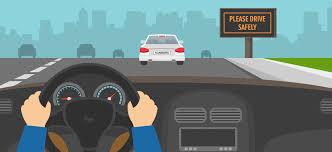Why is Car Driving Difficult? 15 Essential Car Driving Tips
Driving a car can be difficult due to a number of factors. Here are some of the reasons why car driving can be challenging:

- Coordination: Car driving requires a lot of coordination between your hands, feet, and eyes. You need to use the pedals, steering wheel, and gearshift while keeping an eye on the road and other vehicles around you. This can take some time to master, particularly for people who are not used to operating a vehicle.
- Judgment: Driving requires good judgment and decision-making skills. You need to be able to assess the traffic situation, anticipate potential hazards, and make quick and accurate decisions. This can be particularly challenging in busy or unpredictable driving environments.
- Spatial awareness: Driving also requires good spatial awareness, which means being able to judge distances and angles accurately. This is particularly important when parking, changing lanes, or navigating through tight spaces. Spatial awareness can be difficult for some people, particularly those who have not had much experience driving.
- Confidence: Many new drivers lack confidence when they start driving. This can make it difficult to control the car and react quickly in different situations. Confidence comes with experience, but it can take some time for new drivers to build up their skills and feel comfortable on the road.
- Rules and regulations: Learning to drive also involves understanding and following a complex set of rules and regulations, such as traffic laws, road signs, and speed limits. This can be challenging, particularly for people who are not used to driving in a particular area or who are new to driving in general.
- Multitasking: Driving requires multitasking skills, such as maintaining speed, changing gears, and keeping an eye on the road while also paying attention to other vehicles, pedestrians, and road hazards. This can be overwhelming for some people, particularly when they are first learning to drive.
- Nervousness: Nervousness can be a major challenge for new drivers. It can affect your ability to focus, make decisions, and react quickly in different situations. Nervousness is normal, but it can make it difficult to learn how to drive if it is not managed effectively.

Overall, car driving can be difficult due to the many skills, knowledge, and behaviors required to drive safely and confidently. It takes time, patience, and practice to become a proficient driver. However, with proper training and support, most people can learn how to drive and become safe and responsible drivers.
15 Essential Car Driving Tips:
Here are 15 essential car driving tips that can help you become a safe and confident driver:
- Adjust your seat and mirrors: Before you start driving, adjust your seat so you are comfortable and have good visibility. Also, adjust your mirrors so you can see behind and to the sides of your car.
- Wear your seatbelt: Always wear your seatbelt when driving, and make sure your passengers do the same. Seatbelts can save lives in the event of an accident.
- Use turn signals: Always use your turn signals when changing lanes or turning. This lets other drivers know your intentions and can help prevent accidents.
- Check your blind spots: Before changing lanes, check your blind spots by looking over your shoulder. This will help you see any cars or motorcycles that may be in your blind spots.
- Maintain a safe following distance: Leave enough space between your car and the car in front of you to allow for sudden stops or changes in speed.
- Observe speed limits: Always obey speed limits and adjust your speed based on road conditions. Going too fast can make it difficult to control your car and react to unexpected situations.
- Keep your hands on the wheel: Keep both hands on the steering wheel at all times, except when shifting gears or operating controls. This will help you maintain control of the car and react quickly to any changes in driving conditions.
- Scan the road ahead: Look ahead and scan the road for potential hazards or changes in driving conditions. This will give you more time to react and avoid accidents.
- Avoid distractions: Avoid using your phone, eating, or doing other activities that can distract you from driving. Distracted driving is a major cause of accidents.
- Don’t drive under the influence: Never drive under the influence of drugs or alcohol. This impairs your ability to drive and can be deadly.
- Stay alert: Avoid driving when you are tired or drowsy. This can affect your reaction time and decision-making skills.
- Yield to pedestrians: Always yield to pedestrians, particularly at crosswalks and intersections.
- Be aware of weather conditions: Adjust your driving based on weather conditions, such as rain or snow. This may mean slowing down or increasing your following distance.
- Know your vehicle: Familiarize yourself with your car’s features, such as anti-lock brakes, traction control, and stability control. This will help you use them effectively in different driving conditions.
- Practice, practice, practice: The more you practice, the more comfortable and confident you will become behind the wheel. Find opportunities to practice driving in different situations, such as in heavy traffic or on the highway.

By following these essential car driving tips, you can become a safe and responsible driver, and reduce your risk of accidents on the road. Remember that driving requires focus, attention, and patience, so always stay alert and aware of your surroundings.
Driving a car can be difficult due to a number of factors. Here are some of the reasons why car driving can be challenging:

- Coordination: Car driving requires a lot of coordination between your hands, feet, and eyes. You need to use the pedals, steering wheel, and gearshift while keeping an eye on the road and other vehicles around you. This can take some time to master, particularly for people who are not used to operating a vehicle.
- Judgment: Driving requires good judgment and decision-making skills. You need to be able to assess the traffic situation, anticipate potential hazards, and make quick and accurate decisions. This can be particularly challenging in busy or unpredictable driving environments.
- Spatial awareness: Driving also requires good spatial awareness, which means being able to judge distances and angles accurately. This is particularly important when parking, changing lanes, or navigating through tight spaces. Spatial awareness can be difficult for some people, particularly those who have not had much experience driving.
- Confidence: Many new drivers lack confidence when they start driving. This can make it difficult to control the car and react quickly in different situations. Confidence comes with experience, but it can take some time for new drivers to build up their skills and feel comfortable on the road.
- Rules and regulations: Learning to drive also involves understanding and following a complex set of rules and regulations, such as traffic laws, road signs, and speed limits. This can be challenging, particularly for people who are not used to driving in a particular area or who are new to driving in general.
- Multitasking: Driving requires multitasking skills, such as maintaining speed, changing gears, and keeping an eye on the road while also paying attention to other vehicles, pedestrians, and road hazards. This can be overwhelming for some people, particularly when they are first learning to drive.
- Nervousness: Nervousness can be a major challenge for new drivers. It can affect your ability to focus, make decisions, and react quickly in different situations. Nervousness is normal, but it can make it difficult to learn how to drive if it is not managed effectively.

Overall, car driving can be difficult due to the many skills, knowledge, and behaviors required to drive safely and confidently. It takes time, patience, and practice to become a proficient driver. However, with proper training and support, most people can learn how to drive and become safe and responsible drivers.
15 Essential Car Driving Tips:
Here are 15 essential car driving tips that can help you become a safe and confident driver:
- Adjust your seat and mirrors: Before you start driving, adjust your seat so you are comfortable and have good visibility. Also, adjust your mirrors so you can see behind and to the sides of your car.
- Wear your seatbelt: Always wear your seatbelt when driving, and make sure your passengers do the same. Seatbelts can save lives in the event of an accident.
- Use turn signals: Always use your turn signals when changing lanes or turning. This lets other drivers know your intentions and can help prevent accidents.
- Check your blind spots: Before changing lanes, check your blind spots by looking over your shoulder. This will help you see any cars or motorcycles that may be in your blind spots.
- Maintain a safe following distance: Leave enough space between your car and the car in front of you to allow for sudden stops or changes in speed.
- Observe speed limits: Always obey speed limits and adjust your speed based on road conditions. Going too fast can make it difficult to control your car and react to unexpected situations.
- Keep your hands on the wheel: Keep both hands on the steering wheel at all times, except when shifting gears or operating controls. This will help you maintain control of the car and react quickly to any changes in driving conditions.
- Scan the road ahead: Look ahead and scan the road for potential hazards or changes in driving conditions. This will give you more time to react and avoid accidents.
- Avoid distractions: Avoid using your phone, eating, or doing other activities that can distract you from driving. Distracted driving is a major cause of accidents.
- Don’t drive under the influence: Never drive under the influence of drugs or alcohol. This impairs your ability to drive and can be deadly.
- Stay alert: Avoid driving when you are tired or drowsy. This can affect your reaction time and decision-making skills.
- Yield to pedestrians: Always yield to pedestrians, particularly at crosswalks and intersections.
- Be aware of weather conditions: Adjust your driving based on weather conditions, such as rain or snow. This may mean slowing down or increasing your following distance.
- Know your vehicle: Familiarize yourself with your car’s features, such as anti-lock brakes, traction control, and stability control. This will help you use them effectively in different driving conditions.
- Practice, practice, practice: The more you practice, the more comfortable and confident you will become behind the wheel. Find opportunities to practice driving in different situations, such as in heavy traffic or on the highway.
By following these essential car driving tips, you can become a safe and responsible driver, and reduce your risk of accidents on the road. Remember that driving requires focus, attention, and patience, so always stay alert and aware of your surroundings.





